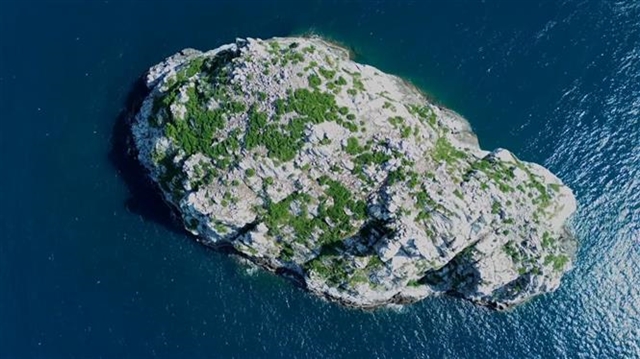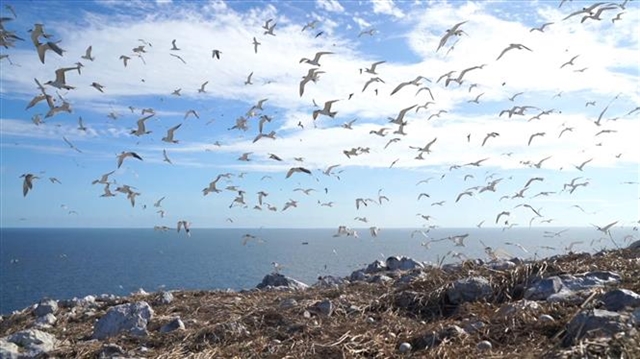 Environment
Environment

 |
| A flock of birds at Hòn Trứng Bird Sanctuary in the Côn Đảo National Park the southern province of Bà Rịa-Vũng Tàu.—VNA/VNS Photo Huỳnh Sơn |
BÀ RỊA-VŨNG TÀU — The Việt Nam Record Organisation (VietKings) has officially recognised Hòn Trứng as a special seabird breeding habitat.
The tiny island, in the southern province of Bà Rịa-Vũng Tàu, under the Côn Đảo National Park, has the highest breeding density for many specific species in Việt Nam.
Hòn Trứng, which spans just under two hectares, was awarded special certification on Thursday.
 |
| The Hòn Trứng Bird Sanctuary in the Côn Đảo National Park the southern province of Bà Rịa-Vũng Tàu.—VNA/VNS Photo Huỳnh Sơn |
The island, which is devoid of human habitation and characterised by sparse grass and rocks, has become a crucial breeding ground for several rare seabird species.
Among the species found there are the black-backed tern, the greater crested tern, the white-bellied sea eagle, the white-rumped swiftlet and the grey-headed tern.
Surveys indicate an impressive average egg density of 4.88 eggs per square metre.
 |
| The Hòn Trứng Bird Sanctuary in the Côn Đảo National Park the southern province of Bà Rịa-Vũng Tàu.—VNA/VNS Photo Huỳnh Sơn |
Also at the certification ceremony, the Việt Nam Association for Conservation of Nature and Environment presented 24 Heritage Trees certificates to the national park’s Management Board, in celebration of Việt Nam's Forestry Day (November 28, 1959 – November 28, 2024).
Among the recognised trees were a 237-year-old almond tree at Bảy Cạnh Island (seven metres in circumference, 17 metres tall), a 155-year-old almond tree at Ông Đụng Beach (4.6 metres in circumference, 14 metres tall), a 237-year-old sao đen (Hopea odorata Roxb) tree at Dài Beach (7.9 metres in circumference, 25 metres tall) and a cluster of 21 phong ba (Heliotropium foertherianum) trees at Cau Island, some 119 years old.
 |
| Greater crested terns at the Hòn Trứng Bird Sanctuary in the Côn Đảo National Park the southern province of Bà Rịa-Vũng Tàu.—VNA/VNS Photo Huỳnh Sơn |
Côn Đảo District has recognised a total of 105 heritage trees, including almond, Lagerstroemia, thị (Diospyros decandra, Sonneratia) and red mangrove trees.
Speaking at the ceremony, Nguyễn Khắc Pho, Director of the national park’s Management Board, said that the recognition of the Heritage Trees and the establishment of Hòn Trứng as the country’s most densely populated seabird sanctuary represent significant milestones.
“The honours reflect the park's and the local community's commitment and efforts to preserving and promoting the value of Việt Nam’s natural heritage,” he said.
 |
| The Hòn Trứng Bird Sanctuary in the Côn Đảo National Park the southern province of Bà Rịa-Vũng Tàu.—VNA/VNS Photo Huỳnh Sơn |
He also said that the efforts not only contributed to sustainable development, but also raised awareness about environmental conservation and cultural heritage.
Under such initiatives, the national park, businesses and residents together fostered the creation of diverse and enriching tourism products, supporting the local economy while promoting Côn Đảo Island and the province as premier destinations for both domestic and international visitors.
Sea turtle conservation
On the same afternoon, the national park’s Management Board, in collaboration with the International Union for Conservation of Nature (IUCN), held a ceremony to conclude the 2024 sea turtle conservation volunteer programme.
This year, more than 140 volunteers participated in the programme, which took place at the national park.
The volunteers, split into seven groups, began their work in Côn Đảo Island on June 13 and completed their efforts by August 21, contributing a total of 1,232 person-days.
The volunteers assisted the park's rangers in various turtle conservation tasks, including monitoring and safely relocating 424 nests containing 44,006 eggs, releasing 12,238 hatchling turtles back into the sea, restoring nesting beaches and maintaining turtle egg incubation facilities.
Volunteers also played a role in educating tourists about sea turtle rescue operations and environmental protection, collecting and disposing of waste on smaller islands, promoting local agriculture and recycling waste materials to create environmental awareness tools and materials.
Launched in 2014 by IUCN in collaboration with the national park, the sea turtle conservation programme has garnered significant attention from the public.
More than 500 volunteers have participated in the programme so far, which peaks during the turtle nesting season (from June to September every year).
Volunteers come from a wide range of backgrounds, including students, civil servants, local people, doctors, lawyers, artists, teachers and journalists.
Biodiversity
According to recent surveys, the national park is home to 1,077 plant species from 640 genera and 160 families of vascular plants as well as 155 animal species from 64 families and 26 orders of animals, including 25 mammal species, 85 bird species, 32 reptile species and 13 amphibian species.
The park’s vegetation is characteristic of tropical island ecosystems, with diverse habitats such as evergreen broadleaf forests, semi-deciduous forests, bamboo and coastal mangrove forests.
In addition to conserving the natural forest ecosystems, the park has prioritised scientific research and the preservation of endangered plant species.
Over the years, research projects have focused on initiatives such as planting mangroves on sandy soils and dead coral reefs on several islands, reforesting areas affected by Typhoon Linda in 1997 and studying the ecological characteristics and propagation of the red mangrove (a rare and endangered species firstly discovered in the island).
Alongside scientific research and conservation, the national park also places significant emphasis on preserving and enhancing the value of its ancient trees, many of which are centuries-old and hold substantial cultural, educational, historical, social and ecological significance.— VNS




